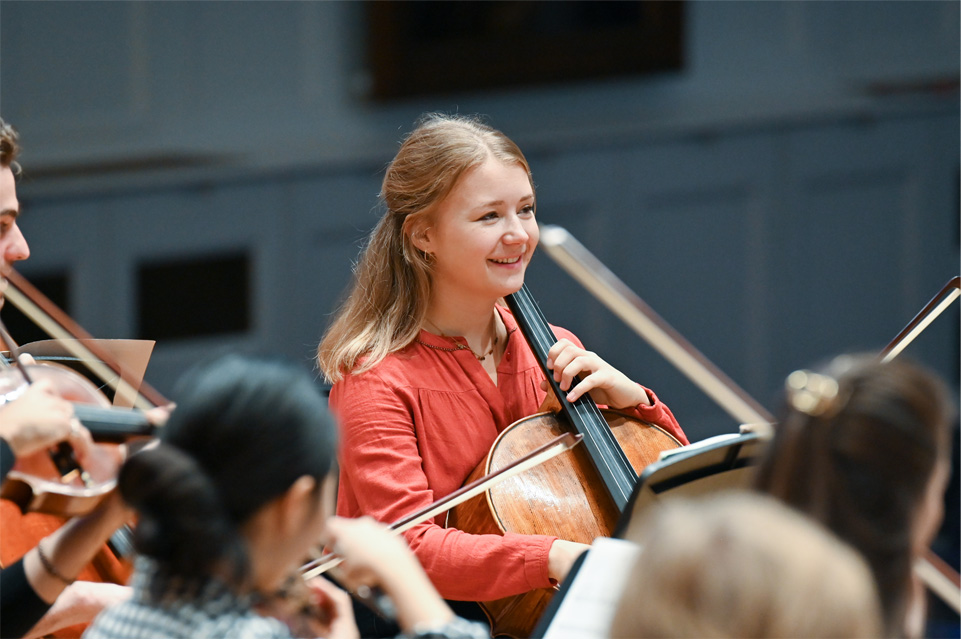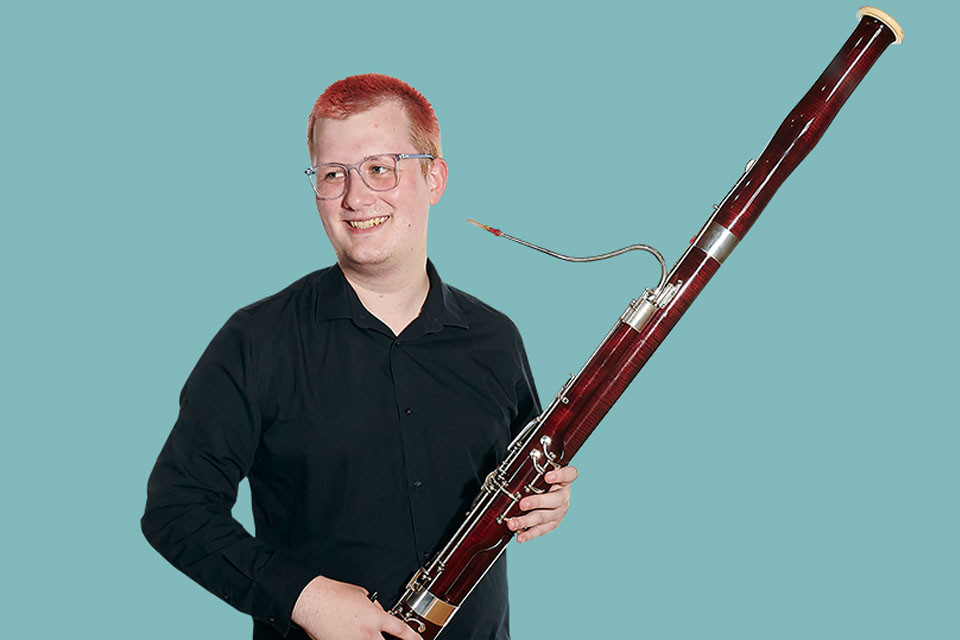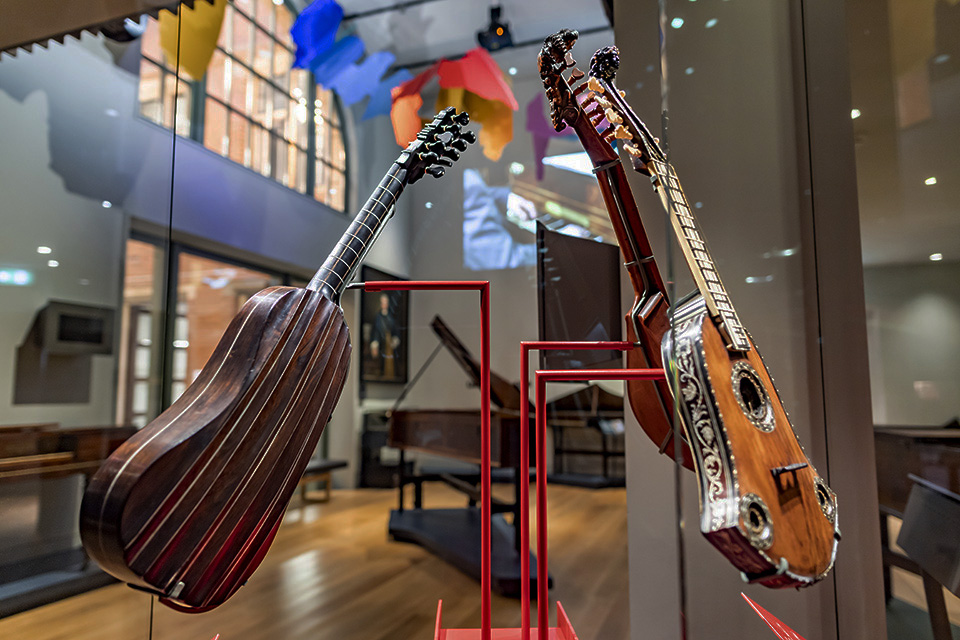15 minute documentary by Norbert Meyn and Terence Curran, 2016
The Legacy of Peter Gellhorn
Introduction by Norbert Meyn
In 2014, Geraldine Auerbach, founder of the Jewish Music Institute in London, presented the RCM Collections with a number of video tapes. Among them were two interviews with the émigré musician Peter Gellhorn in which he spoke about his life and, surprising to many who knew him, about his compositions, which had by then been deposited in the collection of music manuscripts at the British Library. You can watch excerpts from these interviews below.
Peter Gellhorn in conversation with Geraldine Auerbach, Martin Anderson and Betty Sagon Collick, 9 January 2002
By then we had undertaken a great deal of research into the lives and contribution to British culture of émigré musicians like Gellhorn, and this unknown body of works written before and after Gellhorn’s emigration to Britain offered a great opportunity to engage RCM students, colleagues and audiences in a journey of discovery. The purpose of this research project was not to find extraordinary undiscovered masterpieces, but to engage with Gellhorn’s experience as a migrant musician through his music.
With funding from the Arts and Humanities Research Council we were able to produce performing editions of 16 pieces of music, play them in workshops and concerts and record most of them in the studio for the first time. All the recordings and a 15 minute documentary film from the project were published on the RCM’s Youtube Channel, and some of them are embedded below.
Through the work of the project’s Cultural Engagement Fellow, Terence Curran, we were also able to research and publish a comprehensive biographical study of Gellhorn’s life, which accompanies the sheet music edition.
It can be downloaded here:
A shorter version of Gellhorn’s biography is available below, together with a text about his compositions by Eric Levi, who was a partner in this project as a member of the International Centre for Suppressed Music, which was then associated with Royal Holloway, University of London.
Author: Terence Curran
Peter Gellhorn was born in Breslau, Germany (now Wroclaw, Poland) on 24 October 1912. Originally named Hans Fritz Gellhorn, he was known as Peter amongst his friends and family, and formally changed his name to Peter Gellhorn when he became a naturalised British citizen in 1947 (Anon., 1947).
His father, Alfred Gellhorn (1885-1972), was an architect by profession but had also served as an officer in the German army during the First World War. After the war Alfred Gellhorn ‘never fully returned to his family’ and he and his wife Else (1885-1950) separated and eventually divorced, leaving Peter and his younger sister Anneliese (1914-1978) to grow up with their mother (Malet & Grenville, 2002, p. 37).

The family moved to Berlin in 1923 but the absence of his father and the uncertainties of life in the post-war years of the Weimar Republic, including the hyperinflation of the early 1920s, meant that Peter Gellhorn remembered this as a particularly difficult time. Despite this, he received a good education at the Schiller Realgymnasium ‘and was able to pursue his musical studies thanks to a combination of grants and generosity’ (Malet & Grenville, 2002, pp. 10-11). By the age of 16 Gellhorn had enrolled at Berlin’s Staatliche Akademische Hochschule für Musik (affiliated to the Preussischen Akademie der Künste), where his teachers included Richard Rössler (piano), Leo Schrattenholz (composition), and Julius Prüwer (conducting). On completion of his piano studies in 1932 Gellhorn was awarded the Akademie’s gold medal as one of its most outstanding students, before entering Prüwer’s conducting class. He is also known to have attended the lectures of Paul Hindemith, and to have commenced studies in philosophy at the University of Berlin although he was unable to complete his course.

Gellhorn’s gold medal
Author: Terence Curran
By the time Gellhorn completed his musical studies in 1934 he had already begun to establish a reputation as a conductor, pianist, and composer in Berlin. He had also made significant friendships with musicians including the violinist Maria Lidka, and singer Elisabeth Schwarzkopf, both of whom remained lifelong friends. In 1933, however, the National Socialist Party gained power in Germany and began its persecution of Jews. Gellhorn’s father, Alfred, was Jewish and had also been linked to socialist groups including the Novembergruppe, so had to leave Germany immediately, travelling to South America. Peter Gellhorn, however, was only half-Jewish and so was able to remain in Germany, although as the Nazi government began to impose restrictions on the employment of Jews he found it increasingly difficult to find work, and especially so after his name was published in Das musikalische Juden-ABC (Rock & Brückner, 1935, p. 117), a book listing Jewish musicians.
Fortunately, Gellhorn had been introduced to Philip Loretz and Lionel Robbins, English friends of the film-maker Lotte Reiniger, for whom Gellhorn had written several film scores. They agreed that if Gellhorn felt he was in danger he should contact them and they would write to invite him for a ‘holiday’ in England. This duly happened and Gellhorn fled Germany in September 1935, travelling via France to England. In an interview in which he recalled his escape, Gellhorn stated that he visited friends in Saarbrücken en route (Malet & Grenville, 2002, p. 79). It is now known that Inge Camphausen, a singer based at the Saarbrücken Opera, helped him to cross the border into France where he was able to make contact with Lotte Reiniger in Paris before making his way to England. Gellhorn and Camphausen never met again and Camphausen was killed in the bombing of Dresden in February 1945.
After arriving in England Gellhorn stayed with Philip Loretz in Ascot before moving to London where he found employment as a ‘resident volunteer’ at Toynbee Hall in the East End of London, working in the music department under John Tobin. During this period he taught piano and harmony, directed chamber groups, arranged music for various ensembles, and also wrote incidental music for productions by the theatre players. Gellhorn also conducted his first opera at Toynbee Hall in a production of Gluck’s Orpheus, with the performance described by the critic of The New Statesman and Nation as ‘conducted with understanding and sympathy’ (Turner, 1939).
With the outbreak of war in 1939 Toynbee Hall ceased activities and Gellhorn went to stay with friends in Devon, returning to London occasionally. In the summer of 1940, however, the British government decided to place ‘enemy aliens’ in internment camps and on a return visit to London Gellhorn was arrested. He was sent first to a camp at Warth Mills, near Bury in Lancashire, and from there to Mooragh Camp, at Ramsey on the Isle of Man. While at Mooragh he gave piano recitals, played the organ in the local church, directed ensembles and choirs, and composed several works including two studies for violin, two works for string quartet, and a work for strings and male voices, Mooragh, in a setting of words by F. F. Bieber, a fellow internee. Gellhorn was eventually released on 21 January 1941 after intervention by Ralph Vaughan Williams in his role as chair of the Committee for the Release of Interned Alien Musicians.
Gellhorn initially returned to London but later went to stay with Jo Hodgkinson and his wife, Winnie. Jo Hodgkinson had been deputy warden at Toynbee Hall but was also a theatre director and was by then working as manager of the Vic-Wells (later Sadler’s Wells) Company, which was based in Burnley, Lancashire for the duration of the war. Through Hodgkinson, Gellhorn was introduced to Lawrance Collingwood and Joan Cross, the directors of the Vic-Wells Opera. Recognising his experience, they invited Gellhorn to join the company as a répétiteur and assistant conductor. Gellhorn subsequently toured with the company, gaining invaluable experience. Through the company he also met Olive Layton, who was a member of the Chorus and whom he later married. On the evening of their wedding at Caxton Hall, London in May 1943 Gellhorn was invited to conduct a performance of Traviata, with Joan Cross and Peter Pears singing the lead roles.
Gellhorn continued to work for the Vic-Wells Company until he was called up for war work in October 1943. He was assigned to an electrical factory in London, overseeing the production of aircraft parts, and worked there for two years, occasionally conducting with the Vic-Wells Company if it was performing in or near London. He was eventually discharged in November 1945 but by this time Peter and Olive had started a family and Gellhorn needed work. Fortunately, he was introduced to H. B. Phillips, director of the Carl Rosa Opera Company, who engaged him as conductor. Gellhorn made his first appearance with the company on 6 December 1945, conducting Gounod’s Faust at the Wimbledon Theatre, and over the course of the next 12 months conducted a total of 115 performances of various operas.

Covent Garden Concert programme
In the meantime Gellhorn had come to the attention of David Webster, who had been appointed as general administrator of the newly reopened Covent Garden opera house and had recruited Karl Rankl as music director. In 1947 Webster invited Gellhorn to join the staff at Covent Garden as Head of Music Staff and assistant to Rankl, and he gave his first performance at Covent Garden on 7 June 1947, conducting Mozart’s Magic Flute. Over the course of seven years he conducted over 260 performances at Covent Garden and on tour, while also working as répétiteur and coach.
 16x9.jpg)
Author: Terence Curran
In 1954 Gellhorn began working at Glyndebourne, first as a coach, then as chorus master and, later, as a conductor, conducting 30 performances between 1956 and 1961. However, letters at the British Library suggest that Gellhorn became frustrated by the lack of opportunities to conduct at Glyndebourne and so in 1961 he joined the BBC as Director of the BBC Chorus (later known as the BBC Singers). His tenure coincided with that of William Glock, who encouraged the programming of a wide variety of repertoire, including contemporary music, and Gellhorn also collaborated with a series of leading conductors including Antal Dorati, Colin Davis, and Pierre Boulez. The BBC’s then policy meant, however, that he was forced to retire at the age of 60 in 1972.
 with colleagues at Glyndebourne 16x9.jpg)
Glyndebourne Music staff meeting in the 1950's, left to right: Paul Hamburger, Bryan Balkwill, Paul Sacher, Martin Isepp, Howard Wicks (music librarian), Jani Strasser, Ellen Morganthau (regulating secretary), Peter Gellhorn ), credit: Guy Gravett / Glyndebourne Productions Ltd / ArenaPAL
In the years following his departure from the BBC, Gellhorn remained active as a conductor, working regularly with various groups including Morley College Opera, London Opera Players, and the Barnes Choir, as well returning to Glyndebourne as conductor and chorus master in 1974 and 1975. As a pianist he continued to give recitals and to work with singers and chamber groups, touring in a piano duo with Margaret Bruce and with the soprano Rhonda Bachmann, amongst others. He also taught extensively, both privately and at institutions including the National Opera Studio, Dartington, the Guildhall School of Music and Drama, and the Royal College of Music.
Peter Gellhorn died at Kingston Hospital, Kingston-upon-Thames, on 13 February 2004.
Author: Eric Levi
Peter Gelhorn was an exceptionally versatile musician. Equally gifted as composer, conductor, opera coach and pianist, he benefited from a thoroughly grounded musical education at the University of Berlin and the Prussian Academy of Arts, two of the most prestigious institutions in the country. Furthermore, his formative years as a student in Berlin took place against the backdrop of the later years of the Weimar Republic, arguably the most dynamic cultural environment of the twentieth century. As a young man, Gellhorn would almost certainly have been fully aware of a host of significant figures operating in the German capital such as composers Arnold Schoenberg, Paul Hindemith. Franz Schreker and Alexander Zemlinsky, or conductors Erich Kleiber, Wilhelm Furtwängler and Bruno Walter.
It’s clear that Gellhorn was already an accomplished composer at a relatively early age. A good example of his youthful mastery is the four movement Kleine Suite for Oboe and Piano composed in 1932. As its title suggests, this work can be regarded on one level as a typical product of neue Sachlichkeit, a cool neo-classical composition written in a highly chromatic yet tonal idiom with closely worked-out contrapuntal interplay.
Kleine Suite for Oboe and Piano (1932) by Peter Gellhorn
Rebecca Watt, oboe, Lucy Colquhoun, piano. Recorded at RCM Studios in 2016.
Gellhorn’s 1930s compositions demonstrate some stylistic connections to Hindemith. Yet beneath the surface playfulness of the music lie elements of anxiety, manifested most obviously in the allusions to menacing march rhythms and sinister trills three quarters of the way through the work. To what extent, these musical images are indicative of the unsettled political situation in Germany, a year before Hitler came to power, is difficult to estimate. Yet they are also present in the much more ambitious First String Quartet, composed between 1933 and 1934. Here Gellhorn demonstrates exceptional understanding of the technical and timbral capabilities of the instruments presenting further refinements in his control of contrapuntal argument. It might be argued that the string textures, particularly in the outer movements are too full-blooded and at times crave for orchestral treatment. But Gellhorn provides necessary emotional and textural contrast in the beautifully elegiac fourth movement dominated by a mournful dialogue shared between the two violins over a pizzicato accompaniment.
String Quartet No. 1 (1933) by Peter Gellhorn
Performed by the Alke Quartet. Recorded 2016 at RCM Studios London, Producer: Raphael Mouterde
Whether the Second String Quartet (completed in 1935) predates Gellhorn’s decision to leave Germany for England, or was written after his emigration remains unclear. Whatever the case, this ambitious often Bartókian four movement work marks quite a significant advance on its predecessor, demonstrating a much tighter control of structure and a more closely argued musical fabric. Texturally the work is bold and arresting. In every sense, it is a significant contribution to the repertoire.
It’s impossible to speculate how Gellhorn’s music might have developed had the political situation in Germany not driven him out in 1935. Suffice it to say that adaptation to the very different and more parochial cultural environment of his newly adopted country inevitably caused a significant change is his creative outlook. At first, his productivity did not suffer unduly, though the impetus for composing was primarily stimulated by the close musical partnerships he forged on his arrival in the UK. Two substantial works for two pianos a large-scale Sonata (1936) and the Totentanz (1937) illustrate his formidable command of a particularly challenging medium. The second of these works is perhaps the more impressive, its sardonic and often aggressive humour recalling the grotesque distortions of conventional dance rhythms that feature in Ravel’s La Valse. In contrast, two pieces for Violin and Piano, Capriccio (1936) and Intermezzo (1937) are wistful and introverted in character. Only the flighty middle section of the Capriccio offers a momentary relief from an underlying sense of melancholy – a feature which also dominates Gellhorn’s moving setting of Walter de la Mare’s poem Autumn (1938), one of the earliest of his vocal works to set an English text.
Another fascinating work from this period is the Trio Suite of 1937 composed for two violins and viola, the same instrumental combinations as that employed in Dvořák’s Terzetto. As its title suggests, this six-movement work pays homage to JS Bach particularly in the lively fugal gigue of the final movement whose upbeat energy surely recalls the second movement of Brandenburg Concerto No. 3 and in the fourth movement Aria where the violins spin a sinewy melodic line against a trudging pizzicato accompaniment, a musical gesture reminiscent of the famous Air from the Third Orchestral Suite.
By 1938, Gellhorn’s creative impulses were beginning to wane. Perhaps the pressure of securing professional work as a performing musician deflected his attention away from composition. But it is also possible that he was experiencing a sense of dislocation since there is little evidence that the English musical establishment was much interested in hearing his work. We should remember of course that Gellhorn was trying to establish himself in Britain during the difficult years preceding the outbreak of the Second World War. So many fellow refugees found it difficult to adapt to new circumstances and even stopped composing.
A particularly traumatic event in Gellhorn’s life must have been internment as an ‘enemy alien’ on the Isle of Man in 1940. Forced to cohabit in squalid conditions with many fellow refugees, Gellhorn threw himself with abandon into enhancing cultural activities, teaching music and participating in many concerts. One of the most moving products of this period is the short piece Mooragh for male voices and strings, a gloomy and desolate portrayal of daily existence in Ramsey Internment Camp. In contrast an Andante for String Quartet composed around the same time is much more defiant, its aggressive bitonal clashes eventually resolving on an unequivocal and optimistic major chord.
Mooragh by Peter Gellhorn
Andante, Isle of Man 1940
Gellhorn was far less prolific as a composer in the post-war era, focusing much of his attention on an increasingly busy conducting career. Without having comprehensive access to all the works he composed up to his death, it would be premature to make an assessment of his development during this period. Indeed, there is quite a disparity of utterance and intention between the rather eccentric Thoughts on a Chinese Tune for Two Clarinets and Piano Duet (1976) and the far more nostalgic almost Brahmsian setting of I Want To Sing a Song (1949), both impressive demonstrations of Gellhorn’s musical versatility.
Author: Eric Levi
Further information
Visit the original project website
Download PDFs of the Peter Gellhorn Edition here
Watch oral history interviews with Peter Gellhorn’s children Mary Gellhorn and Sangeet Gellhorn

Gellhorn project team 2016











